
Maine Home Garden News — May 2017
- May Is the Month to . . .
- Testing Your Garden Soil — Use a Home Test Kit?
- The Tom Settlemire Community Garden, Brunswick, Maine Master Gardeners Linton and Bonnie Studdiford
- Maine Composts Week: May 7-13
- Be Tick Smart to Prevent Tickborne Diseases
- Food & Nutrition — Fiddleheads and Rhubarb: Maine Foods for May
May Is the Month to . . .
By Donna Coffin, Extension Professor, UMaine Extension Piscataquis County
- Start the following seeds indoors and plan to transplant after all chance of frost has passed in your region (typically late May or early June): cucumbers, melons, pumpkin, sunflower, morning glory, and zinnia (all may also be sown directly in the garden later in the month). Broccoli, Brussels sprouts, cabbage, and cauliflower can be sown indoors in mid-May to establish transplants for a fall crop. Be sure to harden off transplants before setting them out (gradually exposing them to cooler temperatures along with great amounts of light and wind). See Bulletin #2751, Starting Seeds at Home for more information.
- Once hardened off, cool season vegetable seedlings can be transplanted outdoors: lettuce, broccoli, cabbage, onions, leeks, cauliflower, kale, etc. Hold off on transplanting peppers, tomatoes, and eggplant, until the weather is consistently warmer. Cool weather will actually set peppers back.
- Direct sow outdoors: beets, carrots, leaf and head lettuce, peas, radishes, spinach, Swiss chard, and turnips.
- Start mowing lawns when grass is about 3 1/2 inches high. Set mower to cut to about 2 1/2 inches high. Be sure your blades are sharpened for the upcoming season.
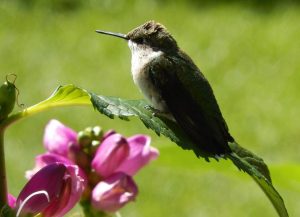 Place hummingbird feeders outdoors. Make your own feed by mixing one part table sugar with four parts boiling water. See Bulletin #7152, Understanding Ruby-Throated Hummingbirds and Enhancing Their Habitat in Maine for more information about the maintenance and sanitation of nectar feeders as well as a list of nectar plants you can add to your garden to attract hummingbirds.
Place hummingbird feeders outdoors. Make your own feed by mixing one part table sugar with four parts boiling water. See Bulletin #7152, Understanding Ruby-Throated Hummingbirds and Enhancing Their Habitat in Maine for more information about the maintenance and sanitation of nectar feeders as well as a list of nectar plants you can add to your garden to attract hummingbirds.- Stake peonies and other plants needing support. It’s much easier to stake now before the plants get too unmanageable.
- Consider putting in an automatic watering system. Automatic watering can be especially helpful with container gardens that have a high demand for water. For more information, see Bulletin #2160, Trickle Irrigation: Using and Conserving Water in the Home Garden.
- Plant strawberries, raspberries, blueberries, apple trees, pear trees, etc. as weather and soil conditions permit.
- Plant an outdoor herb garden. Hardy perennials (chives, mint, thyme, etc.) can be planted in May, but wait until later in the month or early June to install the more tender herbs transplants such as basil and to direct sow dill and cilantro seeds.
- Protect well-developed strawberry buds from frost injury by applying straw mulch when freezing temperatures are in the forecast.
- Remember to check the planting depth of any container-grown or balled and burlapped trees or shrubs. They should be planted at the same depth that they were grown in the nursery. Be sure to remove any rope or twine and snip wire baskets on balled and burlapped plants. For more information, see Bulletin #2411, Planting and Early Care of Fruit Trees.
- When planting trees or shrubs avoid amending soil that will be returned to the planting hole with organic matter. Backfilling with parent soil will encourage the roots to grow out beyond the planting hole. If dealing with very poor soil conditions, consider installing a plant adapted for the challenging soil type (ex: buttonbush for clay soils) or amend the backfill with no more than 25% organic matter.
- Beware of tree volcanoes! Thick mulch against the bark will retain moisture and allow insects and disease easy entry into the plant. Volcano mulching will also encourage roots to grow into the mulch where they are more exposed to cold and drought damage. Do not pile mulch up against the tree when trying to prevent weeds from growing. Instead, form a donut of mulch with a minimum amount of mulch next to the bark of the tree.
- Start new flower beds or expand older ones. If adding soil to create a new garden bed, remember to till the existing soil with the added soil, at least to a depth of 6″ to create a transition layer ensuring better drainage.
- Leave daffodils and other spring bulb foliage in place until it yellows and dies. The leaves produce the food to fuel next season’s blooms. Don’t fold or braid foliage!
Testing Your Garden Soil — Use a Home Test Kit?
By Caragh Fitzgerald, Associate Extension Professor, UMaine Extension Kennebec County
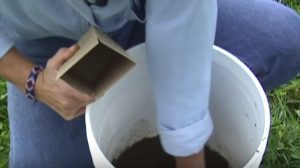 Go to any University of Maine Cooperative Extension gardening talk, and you’ll hear advice to take a soil sample and follow the recommendations. After all, measuring what is already in the soil is the best way to know which nutrients are lacking and how much is needed. It’s like looking in the pantry before going grocery shopping. We usually bring boxes and forms for the UMaine Soil Testing Laboratory to our presentations, and there are private labs that can run nutrient analyses as well.
Go to any University of Maine Cooperative Extension gardening talk, and you’ll hear advice to take a soil sample and follow the recommendations. After all, measuring what is already in the soil is the best way to know which nutrients are lacking and how much is needed. It’s like looking in the pantry before going grocery shopping. We usually bring boxes and forms for the UMaine Soil Testing Laboratory to our presentations, and there are private labs that can run nutrient analyses as well.
Sometimes we’re asked about using home soil testing kits. Gardeners like the idea of home test kits for two reasons: first, the cost per test is less than sending the sample to a lab; second, the results are available immediately. Despite these advantages, I don’t recommend that gardeners rely on these home kits to plan their nutrient applications, and I will explain why.
The purpose of the soil test is to determine whether or not the crop will yield better if a nutrient is added and then to determine how much of that nutrient is needed. Labs chose specific extracts because their results can be related to the likelihood of a yield response. Different chemical extracts will remove nutrients from different storage sites, and they can’t be used interchangeably. For example, phosphorus extracts that are used in regions tending to have acidic soils (pH less than 7) are different than those used in regions tending to have alkaline soils (pH more than 7). Using the wrong extract can give meaningless results.
If it is determined that the crop is likely to respond to additional nutrients, the next step is to determine how much should be added. For example, if phosphorus (P) measures “X” by a particular test and will respond to more P, how much should be added? The recommendations rely on data from years of in-field testing as well as the professional knowledge of University personnel and skilled crop consultants.
So what about the home test kits? They will give a result for the nutrients they test, perhaps one that is numerical or perhaps one that is qualitative (very low, low, optimum, excessive). And they may give recommendations of how much of a nutrient to apply. However, the extractions used with the home test kits and the recommendations are not chosen based on Maine (or New England) soils or cropping conditions. They might work, or they might not. We don’t know the science behind them. Going back to the pantry analogy, a home test kit is like looking in your pantry without turning on the light. You know there are canned goods, but you don’t know if the cans are peaches, cranberry sauce, ravioli, or lychee fruit. So you still don’t know what you need at the store. Your best bet is to get a soil test that uses testing and interpretation methods based on research from Maine.
For more information on testing your garden soil, take a look at Extension Bulletin 2286, “Testing Your Soil.” Your local Extension office will have UMaine Soil Testing Laboratory boxes and forms and can answer any other questions you may have.
The Tom Settlemire Community Garden, Brunswick, Maine Master Gardeners Linton and Bonnie Studdiford
By Kathleen McNerney, Home Horticultural Coordinator, UMaine Extension Cumberland County
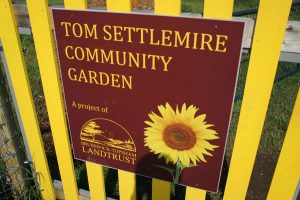 In 1994 the Brunswick-Topsham Land Trust began a 14-year effort to conserve the 321-acre Crystal Spring Farm in Brunswick, Maine. In 2008 the acquisition of the farm was completed and it was placed into conservation. The idea for a community garden was not envisioned at the time of the capital campaign. As far back as 1998 community members expressed an interest in starting a community garden at Crystal Spring Farm, but it was not until 2010 when UMaine Extension Educator, Dr. Richard Brzozowski went to speak to the leaders of the Brunswick-Topsham Land Trust that the idea began to take shape. It was Dr. Brzozowski’s suggestion that an outreach program, involving the community in a meaningful way, would be a great benefit to both the Land Trust and the wider community. This suggestion revived discussion about a community garden and was the seed that sparked the growth of the Tom Settlemire Community Garden.
In 1994 the Brunswick-Topsham Land Trust began a 14-year effort to conserve the 321-acre Crystal Spring Farm in Brunswick, Maine. In 2008 the acquisition of the farm was completed and it was placed into conservation. The idea for a community garden was not envisioned at the time of the capital campaign. As far back as 1998 community members expressed an interest in starting a community garden at Crystal Spring Farm, but it was not until 2010 when UMaine Extension Educator, Dr. Richard Brzozowski went to speak to the leaders of the Brunswick-Topsham Land Trust that the idea began to take shape. It was Dr. Brzozowski’s suggestion that an outreach program, involving the community in a meaningful way, would be a great benefit to both the Land Trust and the wider community. This suggestion revived discussion about a community garden and was the seed that sparked the growth of the Tom Settlemire Community Garden.
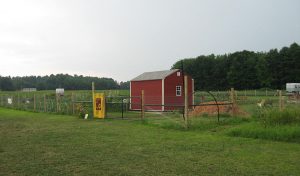
The garden is named for Tom Settlemire, a former Land Trust President, its longest serving Director, and sheep farmer. Tom has been actively involved in the garden, both in establishing it, working, and tilling it, and establishing a scholarship for low-income families which helps pay for seeds and plot fees.
Master Gardener Linton Studdiford (Cumberland County MG 2010) became a member of the Land Trust’s agriculture committee in 2011 and planning for the community garden began in earnest. In the fall of 2011, the initial plot of soil was plowed and fundraising began. At that time there was no fence, no water, and no electricity. The town of Brunswick was going to charge thousands of dollars to bring a city water line to the plot of land and the first estimate for bringing in an electrical infrastructure was $8,000. The plot of land sits atop a post-glacial aquifer and the decision was made to tap into this natural aquifer, so a well was dug. A local excavator donated his services for the project. Three 4-foot-high cement holding containers, each with a 160-gallon capacity, were installed.
On Earth Day 2012, all of the plot holders as well as hundreds of volunteers, including 30-40 Bowdoin College students, began the construction of the garden. On this one day, the paths were dug and wood chips were spread, the original 68 individual plots built (there are now 81 plots), 1,000 feet of fence was installed around the perimeter, composting bins constructed, and the 1/8-acre Common Good Garden was formed. Master Gardener Linton Studdiford coordinated all of the volunteers in this massive one-day effort.

For the first several months the only way to water the garden plots was via a gas-powered generator and pumps that were installed in the water holding tanks. Very quickly it was recognized that this was a rather untenable situation, as it required either Linton or another volunteer be present to operate the generator and the pumps. In 2012, with the help of a hydraulic engineer and Revision Energy, a simple solar-powered water system was installed. Revision Energy supplied the panels and the pump at cost, and volunteers installed the water lines. Now solar panels power a pump, which is activated by float valves in the tanks. This system was expanded in 2013, allowing for an increase in yield and a decrease in the amount of time required by volunteers for the purposes of watering.
The Common Good Garden, in collaboration with the Mid Coast Hunger Prevention Program (MCHPP), provides fresh produce for the MCHPP’s soup kitchen and pantry. This infusion of fresh food, a total of 11,500 pounds in the first five growing seasons alone, has been an invaluable resource and the crowning success of the Common Good Garden. It would not have been possible without the help of hundreds of volunteers, working on average 400 hours per growing season, and the enormous effort by Linton to organize the work.
Even before the Community Garden was built, Master Gardener Linton Studdiford began a Gardening Winter Workshop for the Brunswick-Topsham Land Trust. Linton gave the very first lecture in the winter of 2012. Not knowing what the turnout for the event might be, Linton printed out 20 handouts to accompany his talk. For that first event 65-70 people were in attendance. The series has been going strong ever since then. The workshops are open to the public with a suggested donation of $5, which helps to cover basic costs. Speakers at these events are well-known garden experts, Cooperative Extension personnel, arborists, soil scientists, and many more. The last lecture on the use of native plants in the garden broke all previous attendance records at 106 attendees.
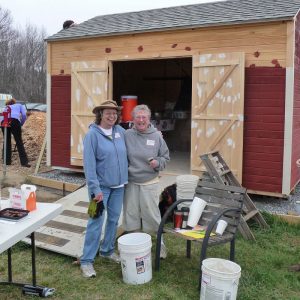
Indeed, Linton has been involved in every aspect of the Tom Settlemire Community Garden, as has his wife Bonnie Studdiford (Master Gardener 2010). Bonnie has been the driving force behind the Tom Settlemire Community Garden’s annual Taking Root Plant Sale since 2012. That very first sale, organized in about one week, consisted mainly of plants from the Studdiford’s own gardens and netted a grand total of $268. The progress and success of these plant sales has grown exponentially over the years. Bonnie always led the way, organizing committees, soliciting donations, potting up and labeling plants, and always looking for better ways to increase the profitability of the sale. Lessons have been learned along the way, which resulted in 2016 being a banner year for this endeavor. Donations of plants were up (with the Studdiford’s supplying 300-400 themselves), credit card sales boomed, and the take away was over $6,800. All of these funds go directly back into the garden and eventually find their way, in the form of donated produce, to the Mid Coast Hunger Prevention Program. This Master Gardener dynamic duo (along with many other dedicated volunteers) has helped make the Tom Settlemire Community Garden what it is today, an unqualified success story and a win-win for all involved in the project. To learn how you can become involved in the Tom Settlemire Community Garden visit their website at BTLT Community Garden.
Maine Composts Week: May 7-13
The first Maine Composts Week, a collaboration of groups and individuals from around the state, is an event for all of Maine that will promote reductions in unused food, sharing unserved food with those who are food insecure, and diverting unused food to composting and anaerobic digestion facilities thereby minimizing the amount of food being disposed.
Events will occur across the state simultaneously and include everything from documentary screenings, composting open houses, to children’s book readings at libraries. There are challenges, contests, and resources geared towards schools, businesses, communities, and households. Participants can try the hand-drawn or digital art challenge or take a selfie of their compost pile or their school’s share table.
Notes organizer Travis Blackmer of the University of Maine, “If you can’t find an event near you, organize one! The only wrong way to do Maine Composts Week is to not do it at all.”
 Got a compost bin out back? Send it in to the Do-It-Yourself Compost Bin Challenge. Make a 30-second advertisement about composting and send it in. Participate in the Mason Jar Challenge for students or the Household Social Media Food Waste Challenge.
Got a compost bin out back? Send it in to the Do-It-Yourself Compost Bin Challenge. Make a 30-second advertisement about composting and send it in. Participate in the Mason Jar Challenge for students or the Household Social Media Food Waste Challenge.
The purpose of Maine Composts Week is to engage the state of Maine on the topics of composting, anaerobic digestion, food insecurity, and solid waste/materials management in an effort to:
- promote business and service providers who excel in organics management;
- reduce wasted materials;
- highlight best practices in organics management;
- promote composting being integrated in K-12 education, businesses, and household behavior;
- provide resources that enable schools, businesses, households, communities, and institutions to compost effectively; and
- promote food diversion as a first option to manage organic materials before composting.
“Maine is doing a lot to fight hunger,” says Blackmer. “From the Food Councils and Gleaning Networks across the state, to local food pantries and hunger events, we can continue to cut down on the 16 percent of Maine that is food insecure and 24 percent of children that do not know where their next meal is coming from.”
At the heart of the issue is landfill capacity, which is limited and valuable. Presently Maine’s solid waste stream is 40 percent organic in nature. These materials, typically wet and dense, are a valuable resource that must be managed and processed properly in order to add value to society. Maine’s recycling (diversion) goal of 50 percent remains unmet and progress has plateaued in the past decade. Maine currently composts only 5 percent of its potentially compostable/digestible material.
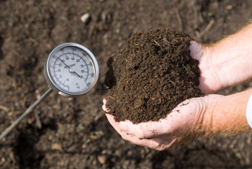 Highlighting composting and other organics management processes, such as anaerobic digestion as well as food diversion and food waste reduction are key ways to make inroads into this larger societal issue. For details on the event, visit the Mitchell Center website or Maine Composts Week on Facebook.
Highlighting composting and other organics management processes, such as anaerobic digestion as well as food diversion and food waste reduction are key ways to make inroads into this larger societal issue. For details on the event, visit the Mitchell Center website or Maine Composts Week on Facebook.
“Find answers to all your composting and related questions on our Maine Composts Week web page, Blackmer notes. “Our favorite tip: Relax! Even if you do everything wrong, you will eventually make great compost.”
Be Tick Smart to Prevent Tickborne Diseases
An announcement from the Maine Center for Disease Control and Prevention
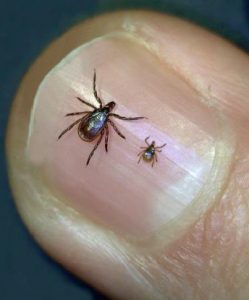
The warmer weather is on its way, which means that we need to be using proper protection methods against ticks and the diseases they carry. Maine had 1,473 cases of Lyme disease reported in 2016 (preliminary as of 3/1/17). May is Lyme Disease Awareness Month each year in Maine, which is the perfect time to remind you to “be tick smart” by doing your daily tick check, since ticks are most active in warmer weather.
Lyme disease is a bacterial infection that is passed through the bite of an infected deer tick. It is most common in adults over the age of 65 years and in children between the ages of 5 and 15 years in Maine. Individuals that work and play outside are more likely to be exposed to ticks. Ticks must be attached for 24-48 hours before Lyme disease can be transmitted, so daily tick checks will allow you to find and remove ticks before getting Lyme disease.
If you are bitten by a tick, or spend a lot of time outdoors, watch for symptoms for up to 30 days, and call your healthcare provider if symptoms develop. The most common symptom of Lyme disease is a skin lesion called erythema migrans (EM), better known as the “bull’s-eye” rash. This usually appears in 3-30 days after the tick bite. Other symptoms include fevers, headaches, and joint or muscle pain.
Lyme disease is treatable and most individuals recover completely with proper drugs. However, the easiest way to avoid the disease is prevention, using “No Ticks 4 ME”:1) Use caution in
- Use caution in tick-infested areas
- Wear protective clothing
- Use an EPA approved repellant
- Perform daily tick checks after any outdoor activity
Lyme disease is not the only disease that can be carried by deer ticks in Maine. Anaplasmosis and babesiosis are two other tickborne infections found in Maine. The number of cases reported for anaplasmosis rose to 372 (preliminary as of 3/1/17) and the number of babesiosis cases rose to 82 (preliminary as of 3/1/17) in 2016.
While the deer tick is the only species of tick in Maine that can transmit Lyme disease, there are other species of ticks found across the state including dog ticks. Tick identification is important, especially when removing ticks, and there are tick identification resources available to order at Maine CDC’s website. The University of Maine Cooperative Extension Tick ID Lab also offers free identification services and educational references.
Additional information:
- Maine CDC has Lyme disease information available on our website.
- Lyme disease data is available through the Maine Tracking Network,
under EPI Information on the left hand side of the page. - University of Maine Cooperative Extension Tick ID Lab submission instructions.
- For additional questions, please call Maine CDC at 1.800.821.5821 or email disease.reporting@maine.gov.
- Tickborne videos can be found on our website, on the left-hand side of the page.
Food & Nutrition — Fiddleheads and Rhubarb: Maine Foods for May
By Kathy Savoie, MS, RD, UMaine Extension Cumberland County
Two of spring’s early edible treats in Maine include rhubarb and fiddleheads. Both of these foods are a pleasure to enjoy in your favorite recipes and these are both very easy to preserve. Once preserved, they can be used and enjoyed again in the off-season. If you are looking to amp up your intake of local foods, preserving is a skill to learn to help extend your access to local foods year round. See a listing of our hands-on food preservation workshops for dates and locations.
Using, Storing, and Preserving Rhubarb
Rhubarb, a spring tonic for vitamin C and calcium, is an easy and versatile fruit to use, although it provides only a moderate source of fiber. One of the drawbacks is that because it is so tart, most recipes call for more sugar than most other desserts. As with other fruits, 1/2 cup cooked rhubarb is considered a serving. A serving without sugar is only 29 calories, but with sugar it is 139 calories. By combining the stalks with sweeter fruits, like strawberries, the sugar content can be lowered quite a bit.
To store rhubarb, cut off the leaves, wash the stalks and store them in a plastic bag in the crisper of the refrigerator. Use within one week. (Caution: Rhubarb leaves contain a toxic substance that makes them poisonous. Be sure the leaves are removed before using the stalks. Discard them without cooking or eating.) See Bulletin #4266, Vegetables and Fruits for Health: Rhubarb for recipes.
Freezing rhubarb is a simple and quick way to preserve it. View our video for step-by-step instructions.
Because rhubarb is a high-acid product, it can safely be processed in a boiling water bath. For directions on how to can stewed rhubarb, check out the National Center for Home Food Preservation website.
Using and Preserving Fiddleheads
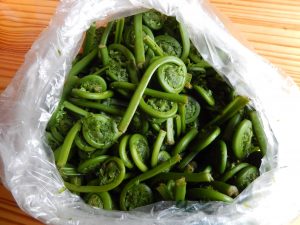 Fiddleheads, an early spring delicacy throughout their range, are the young coiled fronds of the ostrich fern (Matteuccia struthiopteris). Many people mark the arrival of spring with a fiddlehead-picking outing. But, shh, don’t tell where your pickin’ spot is!
Fiddleheads, an early spring delicacy throughout their range, are the young coiled fronds of the ostrich fern (Matteuccia struthiopteris). Many people mark the arrival of spring with a fiddlehead-picking outing. But, shh, don’t tell where your pickin’ spot is!
Some important food safety advice for fiddlehead consumers: The Center for Disease Control and Prevention (CDC) has investigated a number of outbreaks of food-borne illness associated with fiddleheads. The implicated ferns were eaten either raw or lightly cooked (sautéed, parboiled or microwaved). The findings of this investigation recommend that you should cook fiddleheads thoroughly before eating. Under no conditions should fiddleheads be consumed raw.
Cooking Fiddleheads
Fiddleheads can be safely cooked using two different methods, boiling and steaming.
Boiling
Bring lightly salted water in a pot to a rolling boil and add washed fiddleheads. The water should fully cover fiddleheads when added. Bring the water back to a steady boil and hold for 15 minutes.
Steaming
Bring a small amount of water to a boil, preferably in steam apparatus. Add washed clean fiddleheads and steam for 10-12 minutes.
Serve at once with optional melted butter and/or vinegar. The sooner they are eaten, the more delicate their flavor. They may be served, like asparagus, on toast. Cooked, chilled fiddleheads can be also served as a salad with an onion and vinegar dressing.
Sautéing, stir-frying or microwaving ostrich fern fiddleheads are NOT recommended methods for cooking fiddleheads. Fiddleheads should be boiled or steamed prior to use in recipes that use further cooking methods like sauteing, stir-frying or baking.
Source: Food Safety Tips for Fiddleheads, Health Canada.
For information and recipes on how to harvest, clean, use, store and preserve (freezing and pickling) fiddleheads, see Bulletin #4198, Facts on Fiddleheads.
University of Maine Cooperative Extension’s Maine Home Garden News is designed to equip home gardeners with practical, timely information.
Let us know if you would like to be notified when new issues are posted. To receive e-mail notifications fill out our online form.
For more information or questions, contact Kate Garland at katherine.garland@maine.edu or 1.800.287.1485 (in Maine).
Visit our Archives to see past issues.
Maine Home Garden News was created in response to a continued increase in requests for information on gardening and includes timely and seasonal tips, as well as research-based articles on all aspects of gardening. Articles are written by UMaine Extension specialists, educators, and horticulture professionals, as well as Master Gardener Volunteers from around Maine, with Katherine Garland, UMaine Extension Horticulturalist in Penobscot County, serving as editor.
Information in this publication is provided purely for educational purposes. No responsibility is assumed for any problems associated with the use of products or services mentioned. No endorsement of products or companies is intended, nor is criticism of unnamed products or companies implied.
© 2017
Call 800.287.0274 (in Maine), or 207.581.3188, for information on publications and program offerings from University of Maine Cooperative Extension, or visit extension.umaine.edu.
